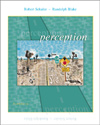| After studying the chapter, the student should be able to...
1.) Compare and contrast the two primary theories developed to explain the
robustness of object recognition. Specify the strengths and weaknesses of each
theory. 2.) Explain what is meant by "learning to see" and give some examples
supporting the contention that we do in fact "learn to see". 3.) Discuss the inferotemporal (IT) cortex including its location and function
with respect to object recognition. Give some examples of the plasticity of
the IT cortical neurons. 4.) Explain prosopagnosia including symptoms and why pinpointing a specific
brain region associated with this disorder is difficult. 5.) Discuss the role of attentional processes in object recognition. 6.) Explain inattentional blindness and give an example. 7.) Discuss the distinction between visual perception and imagery and provide
an explanation as to why people often confuse the two. 8.) Discuss the neural structures or brain regions thought to be common to
both visual perception and visual imagery. 9.) Specify the major perceptual aspects involved in reading and discuss the
role each process plays in successful reading comprehension. The discussion
should include explanations as to why this seemingly simple task is really quite
complex. 10.) Discuss and provide examples of how an individual's experiences and expectations
can influence object recognition. | 


 2002 McGraw-Hill Higher Education
2002 McGraw-Hill Higher Education